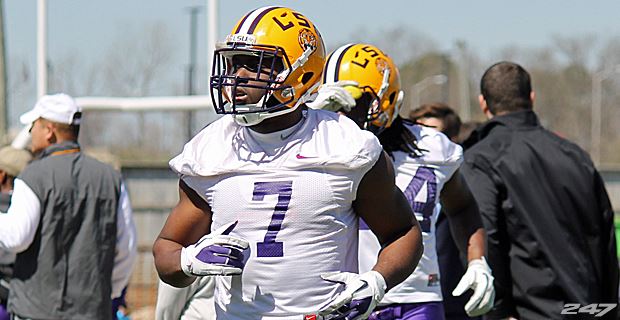
It’s a fact. If you are going to have a successful college football program, you must recruit your own state at a high level.
 LSU is one of the best jobs in the country thanks to elite in-state talent like Leonard Fournette.
LSU is one of the best jobs in the country thanks to elite in-state talent like Leonard Fournette.
Granted, not all states are created equal and some programs by nature of geography are forced to build the majority of their rosters with out-of-state talent, but even if it is simply signing the handful of worthy prospects in your own state each year, it is imperative that a program does so.
College football is still very much regionally-rooted. A prospect that grows up in your state knows all about what it means to be a part of your program, regardless of the recent success level. Your program is part of the fabric of society within your state. That’s part of what makes college football special. Therefore, the in-state prospects are always going to “get it” in terms of what it means to play for your school.
That helps to facilitate a higher standard and work ethic on your roster. Leadership comes from within most of the time and these guys are equipped to help set the standard from the first day because that’s who they are.
Also, let’s face it, it’s not as difficult to ward off the blue bloods of college football when you are dealing with an in-state prospect rather than trying to battle out-of-state. Most college football players still prefer to play within reasonable proximity of their home. You have the home-field advantage.
Does recruiting well in-state lead to winning? Here are some bullet points to consider.
Major Examples
Let’s take a look at the last three national champions- Alabama, Florida State and Ohio State, as examples.
-The rise of the Crimson Tide program under head coach Nick Saban was facilitated by the 2008 recruiting class, which was ranked third nationally and tops in the Southeastern Conference. This class was heavy on in-state stars like receiver Julio Jones, safety Mark Barron, defensive end/linebacker Courtney Upshaw and defensive tackle/end Marcell Dareus. All were key components of Alabama’s run to the 2009 National Title, it’s first since 1992.
-Jimbo Fisher got the Seminoles headed in the right direction with heavy in-state hauls in both the 2010 and 2011 cycles. Lamarcus Joyner, Christian Jones and Kenny Shaw were three key signees in 2010. In 2011, Florida State landed Karlos Williams, Devonta Freeman, Kelvin Benjamin, Timmy Jernigan, James Wilder Jr., Bobby Hart, Rashad Greene and Nick O’Leary- all from the Sunshine State and all among the best at their respective projected positions nationally. This group former the core of the 2013 National Championship team.
-Ohio State recruited well in-state prior to the arrival of Urban Meyer, so there was no monster in-state haul that facilitated the rise of the Buckeyes, but consider the Cardale Jones, Adolphus Washington, Michael Bennett, Jalin Marshall, Billy Price, Devin Smith (who is living proof that there is speed everywhere) and others all were Ohioans and played key roles in the championship run. I don’t think you would get too many arguments that Ohio State doesn’t need to recruit Ohio, the fifth-highest NFL talent-producing state, with great success in order to continue to have one of the top programs in the country.
Other examples
There are plenty of case studies outside of the last three title winners.
-Ole Miss and Mississippi State have signed nearly 90 percent of the in-state talent rated four stars or better for the past four cycles. It’s no coincidence that both were in the top 10 for most of the 2014 season and both played in “Playoff” bowls. The Bulldogs were ranked No. 1 for several weeks.
-Wisconsin has one of the most consistent programs in the country and while that state isn’t filled with football talent, the Badgers usually get what talent is there, especially when it comes to offensive linemen. Then, a guy like Melvin Gordon comes along and Wisconsin takes full advantage.
-South Carolina won 42 games and the SEC East in four seasons under Steve Spurrier (2010-13) led by in-state products like Stephon Gilmore, Alshon Jeffery, Marcus Lattimore and Jadeveon Clowney.
-The upward trajectory of the Tennessee program has been facilitated by recruiting, which has its roots in that state’s talent level rising.
-Penn State’s roster is coming back quickly, thanks in large part to James Franklin and his staff being dominant in the state of Pennsylvania on the recruiting trail.
-The reason LSU is one of the best jobs in the country- it’s the only Power 5 program in the state of Louisiana, which is annually a top 10 talent-producer.
The What-Ifs
These are programs who could be among the best in college football, but they have an in-state recruiting problem.
-What if North Carolina had had Stephone Anthony, Todd Gurley and D.J. Humphries? All three were Tar Heel state talents that left for Clemson, Georgia and North Carolina respectively. The last time North Carolina was a top 10-type of program? When Mack Brown was coaching there. Brown signed the lion’s share of the in-state talent and had a monster in Chapel Hill before leaving for Texas.
-What if Rutgers could sign 75 percent of the top talent in New Jersey on an annual basis? That would mean that the Scarlet Knights could emerge as a contender with the big four of the Big Ten East (Ohio State, Michigan State, Penn State, Michigan).
-How would successful programs who recruit and evaluate out-of-state well like Arizona, Arizona State and Missouri fare if they could corral the in-state talent in the Grand Canyon and Show-Me States, respectively (more on Arizona later)?
The Outliers
-Oregon doesn’t always land every top prospect out of its state, yet the Ducks have one of the best programs in the country.
-Nebraska’s in-state-heavy walk-on program is a building block for its program, but the Cornhuskers always will have to stock their roster with out-of-state talent.
-Though Notre Dame does quite well recruiting the top talent in Indiana that it wants, the Fighting Irish are a true national recruiting effort and will always go coast-to-coast to build their roster.
-Programs in the Pac-12 must always recruit California because of the size of that state and the amount of talent that state sends to Pac-12 programs on an annual basis. The states of Arizona, Utah and Washington both produce enough talent annually for one program to thrive if it corrals the majority of the in-state talent (unfortunately there are four Pac-12 programs combined in Arizona and Washington, so it’s difficult and the Utes have to compete with BYU in-state and the entire country on high-level Salt Lake-area kids). The Oregon schools and Colorado must go out-of-state (and especially to California) to fill rosters. This is the nature of recruiting in the West. It does not mean that if there are five high level prospects in Portland, Ore., that Oregon or Oregon State should not go all in to sign them. It’s just how things are in that part of the country- California is the spot.
What to Do
So how does a program successfully recruit its own state and what defines owning it? In today’s recruiting climate, it’s likely a little unrealistic to say that any one program is going to get a clean sweep of the elite in-state talent, regardless of what state you are located in.
There also are different measuring sticks with regards to programs located within a “big three” (California, Florida, Texas) state and a non- “big three state”.
Non- “Big Three”
If you are a program in a non- “Big Three” state, here is what is important.
–Sign your share (75 percent) of the elite talent, i.e. the guys that could play just about anywhere in the country, on an annual basis. Then go out-of-state to fill your roster.
–Make great evaluations on three-star level talent within the state and do no lose a prospect that is not highly-regarded, but who can potentially become a great player. This is a worse failure than losing the guy that a bunch of schools want.
–Always extended invited walk-on opportunities to great in-state players who don’t necessarily project at the highest level. Two things happen here- it keeps the top high school programs and coaches happy and some of these guys end up developing into players that can help your program.
–If your school can accept them academically, always target talented junior college players from your state that headed off to get their grades in order or improve as a football player. There are two reasons why you do this. 1. Most of the time, these guys want to come home because they’ve been gone, so it’s not like you have to go on a recruiting crusade to land them. 2. Most of the time, they can come in and help you right away and are pretty talented players. If you are in Mississippi, Kansas, Arizona, Texas or California, it’s easier to monitor because of the junior college systems in those states.
“Big Three”
If you are located in the “Big Three” of California, Florida or Texas, here’s what is important.
–Pay no attention to state rankings by recruiting sites in terms of the numbered order. Only look at who your staff thinks is within the top 15-20 percent of all players within the state. Most of the time, that is going to look a lot like a top 25 from a media outlet that covers recruiting, but there will be differences. There are too many high-level prospects in these states to accurately get a top 20 type of ranking. Most cycles, you could pick from about five prospects to determine the No. 1 prospect in the state and make a good selection. Do your own work in your own state and use that list when determining the no-brainers. State recruiting rankings by media outlets are constant power struggles between the local analysts who have their favorite players because they’ve watched them every Friday night for three years with no comparison nationally and national analysts who have seen bits and pieces on film, in person and more, that are able to compare to other prospects with a much smaller sample size to work with.
–Do not worry about losing a high-level talent because there is somebody just as good on your in-state board behind them. The differences in level of talent when it comes to the big three states are minimal because of the big numbers. For example, the top defensive end in the state of Michigan is in most years a high-level talent. The top 3-5 defensive ends in the state of California are most years high-level talents. The rest is just splitting hairs. So you are going to lose players out of your state that go elsewhere and have good careers. In the big states you are also going to have serious in-state competition. This is good news because sometimes that will be the top national-level guy, but you can easily replace him with one of the other 3-4 on your board at that position and end up with a talented prospect. This also is a a good way to combat in-state competition. For the sheer sake of example only, lets say you are Cal. There are 10 in-state linebackers you really like, they are all more or less the same. USC gets two, UCLA gets two, Stanford is able to take one and three pick out-of-state programs- that still leaves you with two and it’s almost a guarantee those won’t be the bottom two when all is said and done.
–Go out-of-state for only two reasons. 1. To get a great prospect that would be among the best in your state at his specific position or who is among the best in the country (the lock no-brainer types). 2. You have a need that you can’t fill at a high level with in-state talent. This sounds strange because so many programs located in big three states go out-of-state too often (in some cases, like Stanford, they have to because they are looking for a certain type of student athlete) and end up letting great players slide to conference or regional rivals. If you are in Florida, Texas or California, there’s enough to go around and your program will benefit in the long run. I theorize that the national exposure given to college football recruiting has facilitated a phenomenon where schools in the big three unnecessarily go out-of-state for prospects. For example, if a Pac-12 coach from a California school goes and snags a top three, high four-star prospect out of Arizona, that makes bigger headlines than if he ends up landing the three-star kid out of Los Angeles who is just as good, just ranked lower and an easier sell. Roster messes are caused by such actions. Once again, look at Florida State. Tons of recruiting hype during the later Bobby Bowden years and seven-win seasons and 30-0 losses to Wake Forest at home. Fisher comes in, tightens the recruiting focus and the Noles are back among the best in college football.
Bottom Line
Recruiting at a high level in-state (landing your share, making great evaluations and giving preference to in-state talent) can facilitate winning if you do it right. It’s not the only thing that goes into winning in college football, but there are too many examples of its importance for it not to mean anything.
Recruiting Moneyball: Optimizing 3-star talent
Click below for the full article
Recruiting Moneyball: The importance of in-state recruiting
Source: Clemson 24/7



Facebook
Twitter
Pinterest
Instagram
YouTube
RSS